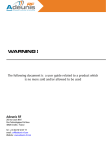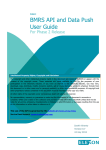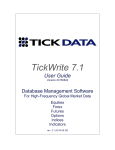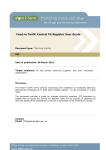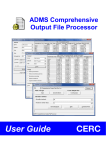Download Trading Operations Report User Guide
Transcript
Trading Operations Report User Guide Intellectual Property rights and disclaimer The copyright and other intellectual property rights in this document are vested in ELEXON or appear with the consent of the copyright owner. These materials are made available for you for the purposes of your participation in the electricity industry. If you have an interest in the electricity industry, you may view, download, copy, distribute, modify, transmit, publish, sell or create derivative works (in whatever format) from this document or in other cases use for personal academic or other non-commercial purposes. All copyright and other proprietary notices contained in the document must be retained on any copy you make. All other rights of the copyright owner not expressly dealt with above are reserved. No representation, warranty or guarantee is made that the information in this document is accurate or complete. While care has been take in the collection and provision of this information, ELEXON Limited shall not be liable for any errors, omissions, misstatements or mistakes in any information or damages resulting from the use of this information or action taken in reliance on it. Trading Operations Report User Guide Version 2.0 Page 1 of 24 © ELEXON Limited 2011 Contents 1 Introduction 3 2 Headline Statistics 4 Energy Contract Volume Notifications 4 The Credit Assessment Price (CAP) 4 System Price Tables 5 Imbalance Volumes 6 Cashflows 6 Demand 7 Number of Metering Systems 8 Generation by Fuel Type 9 Central Services Performance 9 3 CVA Market Charts 10 System Prices 12 Energy Imbalance Volumes 14 System Residual Cashflows 15 Transmission Losses 16 System Reserve 16 4 18 GSP Group Correction Factors 18 Annual Demand Ratio 19 Energy Settled on Metered Data 20 Erroneously Large EAC/AAs 22 Embedded Generation 23 5 24 Terms Used in this Document Contact: The BSC Service Desk BSCServiceDesk@logic a.com 0870 010 6950 10 Credit Cover SVA Market Charts Any questions? Trading Operations Report User Guide Version 2.0 Page 2 of 24 © ELEXON Limited 2011 1 Introduction What is the Trading Operations Report? The Trading Operations Report provides information on the state of the BSC market; including issues and incidents and a summary of the key events that may have had an impact on BSC Parties. The report contains various statistics for a range of key metrics and charts to provide an understanding of any underlying trends. When is the report produced? The Trading Operations Report is produced on a calendar month basis to meet the schedule of BSC Panel meetings as published on the ELEXON website. It is also circulated to the Imbalance Settlement Group (ISG) and the Supplier Volume Allocation Group (SVG). What period does the report cover? The reporting month is the one prior to the current month. Most of the charts and tables in the report use data relating to the reporting month. However, some of the charts and tables are dependent on data from later Settlement Runs and in these cases the statistics will be based on the latest data available. Consequently, the reporting period differs for certain charts. This user guide provides full details of the period covered for each item in the report. Where does the data come from? The data used to compile the Trading Operations Report is acquired from BSC Agents and from ELEXON‟s internal monitoring systems. Data is continually submitted to ELEXON from the BSC Agents and inputted to the Trading Operation Monitoring Analysis System (TOMAS) database. Consequently, this database holds data derived directly from the BSC Agent settlement reports and flows. It holds Balancing Mechanism (BM) Unit details, contract volumes, metered volumes and other data items. ELEXON runs various queries and software applications in order to compile the Trading Operations Report. This happens when the TOMAS database (and other data sources also used for producing the Trading Operations Report), are fully refreshed with a full set of data for the reporting month. Brief descriptions of some of these queries and the methodologies for compiling the different charts are presented in this User Guide. Report Format The layout of the report is as follows: Market Overview This section is split into two sub-sections: Summary where it is intended to provides a brief resume of the operational issues and incidents that arose during the reporting period; and Headlines provides a short statement on other key events that we believe will be of interest to BSC Parties from an operational perspective. Headline Statistics CVA Market Charts SVA Market Charts Trading Operations Report user Guide Version 2.0 Page 3 of 24 © ELEXON Limited 2011 2 Headline Statistics This section of the User Guide provides information on the charts and tables contained in the Headline Statistics section of the Trading Operations Report. The information has been laid out under the same headings as those used in the actual Trading Operations Report. Energy Contract Volume Notifications Chart/Table Table 2.01 Commentary Energy Contract Volume Notification Submissions This table shows the number of Energy Contract Volume Notifications (ECVNs) and Metered Volume Reallocation Notifications (MVRNs) combined, notified to the ECVAA in the reporting period and those that are rejected by the ECVAA. Contract notifications effectively pass through two validation processes. The first is to check the file structure to ensure that the construction of the input file is in accordance with the pre-defined requirements. The second stage is to compare input data against a database that has been previously supplied by the Trading Party. A Contract Notification is considered as rejected if it fails either of these validation stages. Historic information is provided to enable comparisons. Chart 2.02 Daily Average Submitted Notifications and Percentage of Notifications Rejected This chart plots the daily average number of contracts notified to the ECVAA for each calendar month over the latest thirteen months. For comparison purposes the chart also shows the daily average for the previous complete year. Against the secondary Y-axis the percentage of rejected contracts is shown. The Credit Assessment Price (CAP) Chart/Table Chart 2.03 Commentary Weekly Credit Assessment Price (CAP) Trigger Checks The Credit Assessment Price (CAP) is used in monitoring BSC Parties credit cover position. It is intended to be a future estimate of System Buy Price (SBP). The CAP value is set by the Credit Committee, which meets whenever forward energy prices are such that a CAP review is deemed necessary. This is assessed by means of a reference price and a trigger level. The Reference Price is a derived figure, intended to be indicative of future electricity prices, that is weighted on quarterly forward prices (as explained in the CAP Review Guidance document). These forward prices are currently provided by ICIS Heren Energy Limited. The Reference Price is calculated on a weekly basis and compared to the current value of CAP. When the difference exceeds the trigger level then a CAP review will begin. The Credit Trading Operations Report User Guide Version 2.0 Page 4 of 24 © ELEXON Limited 2011 Committee sets the trigger level and reviews this level from time to time. The Weekly Trigger Checks chart shows the Reference Price, as calculated on a weekly basis, and the prevailing CAP value. This chart shows how the value of CAP has been changed when reviews have been triggered, in response to changes in the reference price. System Price Tables The data in the following tables is based on the Energy Imbalance Prices contained in the Best View Prices spreadsheet produced by ELEXON and made available on the ELEXON website in the Data Section. You can find additional information on System Prices in section 3 of the Trading Operations Report. Chart/Table Commentary Tables 2.04 & System Sell Price; & 2.05 System Buy Price These tables show the minimum, maximum, median, mean and standard deviation of the System Sell Price (SSP) and System Buy Price (SBP). The tables cover the last three complete calendar months and the equivalent month from the previous year. Table 2.06 Price Derivation Codes There are a set number of possible pricing circumstances, each of which is defined by a Price Derivation Code (A – L). This table summarises the percentage of occasions within each of the three previous months on which each of the price derivation codes applies and also gives an overview of whether the system has generally been long or short over the month. The data is taken from the latest Settlement Run. The applicable price-setting scenario is partially determined by the sign of the Net Imbalance Volume (NIV), which is calculated as the sum of accepted Bids, accepted Offers and price volume adjusters (BSAA items). The calculation is such that a positive NIV denotes a short system and vice versa. This in turn determines whether the System Buy Price (SBP, always charged to Parties that are short) is the Main or Reverse Price. The Main Price is applied to Parties with imbalance in the same direction (long or short) as the overall system imbalance and is calculated from National Grid balancing costs. The Reverse Price is applied to Parties with imbalance in the opposite direction to the overall system imbalance (i.e. they are helping reduce the system imbalance), and is calculated from Market Index Data (MID). SBP must always be greater than or equal to SSP. When this is not the case, the Reverse Price (whether SSP or SBP) is capped to match the Main Price. When SBP is the Main Price, this is scenario (B) or when SSP is the Main Price this is scenario (G). Trading Operations Report User Guide Version 2.0 Page 5 of 24 © ELEXON Limited 2011 Where there is no Market Index Data, the Reverse Price defaults to the Main Price (C and H). Where NIV is positive but the sum of the total Priced Accepted Offer Volume and the Untagged Buy Price Volume Adjustment (Energy) is zero then both SBP and SSP default to the Market Price (D). The Market Price is a volumeweighted average of the price of eligible short-term forward trades made via the Market Index Data Provider (MIDP) power exchange(s). Where NIV is negative but the sum of the total Priced Accepted Bid Volume and the Untagged Sell Price Volume Adjustment (Energy) is zero then both SSP and SBP default to the Market Price (I). With respect to the scenarios described for codes D and I, if the MID is also zero then both SBP and SSP default to zero (E and J). When NIV is zero (either no balancing actions were required by National Grid or the accepted Bid/Offer volumes and associated adjusters are equal), the system prices default to the Market Price (K) or default to zero in the absence of MID (L). Imbalance Volumes Chart/Table Chart 2.07 Commentary Daily Imbalance Volumes This chart plots the energy volumes associated with the following data items, according to the latest run type data: SBP Short Volume - daily sum across the BSC market of energy imbalance charged at System Buy Price. SSP Long Volume - daily sum across the BSC market of energy imbalance charged at System Sell Price. Noon Effective Temperature (in the Eastern GSP Group, _A) is included to highlight any potential correlation with market conditions. Cashflows Chart/Table Chart 2.08 Commentary Cashflows in the Settlement System The chart provides a high level overview of the three key monthly cashflows for the most recent 13 months for which Initial Settlement (SF) data is available in the Settlement System, together with the Gross Cashflow, as follows. Total Energy Imbalance Cashflow - (marked Total Imbalance Cashflow on the chart) – the total of Energy Imbalance payments to and from Parties in Trading Operations the imbalance market. The value displayed on the chart for each month is the Report User Guide gross value summed over all Settlement Periods in that month. Version 2.0 Total Residual Cashflow Reallocation Cashflow (RCRC) - the Residual Page 6 of 24 Cashflow is calculated to either recover or pay back the net Energy Imbalance © ELEXON Limited 2011 from/to BSC Parties depending on whether the market is long or short. The value displayed on the chart for each month is the gross value summed over all Settlement Periods in that month. Total Balancing Cashflow – the total of payments to and from BSC Parties in the Balancing Mechanism for Accepted Bids and Offers. The value displayed on the chart for each month is the gross value summed over all Settlement Periods in that month. Gross Cashflow - the total gross cashflow within settlement being the sum of the Total Imbalance, Residual and Balancing Cashflows. For more information please consult the Settlement Cashflows information sheet. Demand Chart/Table Chart 2.09 Commentary Total Demand Total Demand is the sum of all Settlement Period consumption volumes. The chart provides an indication as to how this varies during the month and over the year for the most recent 13 calendar months for which SF data available. The maximum, minimum and average are calculated from Settlement Period volumes. Chart 2.10 Energy Settled on the HH/NHH Market The purpose of this chart is to provide an indication of the amount of energy being supplied in the Supplier Volume Allocation (SVA) part of the Settlement System. SVA comprises distribution connected demand. It also includes smaller generation connected to the distribution system but not registered in Central Volume Allocation (CVA). The chart shows the split of energy in the SVA part of the market: energy measured via meters that record half hourly (HH) consumption (the half hourly market) and via the non half hourly (NHH, i.e. profiled) consumption. A plot of the Noon Effective Temperature averaged over all GSP Groups is also included in the chart because temperature data are used to determine the profiled volumes of electricity consumed (or generated) for each non half hourly metering system on each day. This chart should demonstrate any link between temperature and non half hourly volumes. The “Sum of HH Energy” import volumes are the HH consumption volumes, summed across all HH metered import Consumption Component Classes (CCCs). Similarly, the “Sum of NHH Energy” volumes are the NHH consumption volumes summed across all NHH metered import CCCs. The chart therefore shows the total national SVA metered demand settled on actual energy (as opposed to estimates). Trading Operations Report User Guide Version 2.0 Page 7 of 24 © ELEXON Limited 2011 Number of Metering Systems Chart/Table Chart 2.11 Commentary Number of Metering Systems in the Half Hourly and Non-Half Hourly Markets This chart shows the rolling annual change in HH and NHH Metering Point Administration Numbers (MPANs). Generally there is an MPAN assigned for each separate metered supply to premises settled through SVA (see above). The chart therefore provides a high level overview of the growth (or otherwise) in the half-hourly and non half hourly SVA markets. The data on the chart is taken from the Initial Settlement run (SF run) only, i.e. the count of MPANs in that SF run in respect of that Settlement Date. Chart 2.12 Microgeneration: Number of Metering Systems and Energy Exported Not all microgeneration schemes are registered in BSC settlement. This means that many microgeneration schemes are not visible in the Settlement data. This was noted by the Authority (Ofgem) in its decision letter regarding Modification Proposal P218 “Facilitating Microgeneration within the BSC” (May 2008) as follows. “Currently, only a very small proportion of microgeneration sites are registered in settlement. Under the present arrangements established by P081 “Removal of the Requirement for Half Hourly Metering on Third Party Generators at Domestic Premises”, suppliers are required to register a separate non-half hourly export MPAN for each microgeneration site in order to register export for settlement purposes. The proposer suggests that the costs to the supplier associated with separate export meters are greater than the energy benefit, due to the relatively small amounts of energy concerned, and that therefore suppliers may incur a loss by entering these sites into settlement, accounting for the small proportion of sites registered. As a result, surplus energy from microgeneration exported back to the system is spilled and smeared across NHH suppliers as part of the GSP Group Correction process.” With the above caveat in mind, this chart shows the number of MPANs associated with microgeneration schemes registered in SVA settlements and the energy in MWh exported by these schemes into the Non Half Hourly Market. The data is summed from the number of MPANs associated with Consumption Component Classes 32 and 33 (metered NHH Active Export) and the daily total energy that those MPANs export to the system (actual (33) and estimated (32)). Trading Operations Report User Guide Version 2.0 Page 8 of 24 © ELEXON Limited 2011 Generation by Fuel Type Chart/Table Chart 2.13 Commentary Sum of CVA Generation by Fuel Type per Settlement Date This chart provides the sum of Settlement Date Central Volume Allocation (CVA) registered generation by fuel type, over a full calendar month. The relationship between generating Balancing Mechanism (BM) Units and fuel type was initially supplied to ELEXON by National Grid and has been updated on a routine basis. Fuel type data for new BM Units registered in CVA is provided by the Party registering the BM Unit. Chart 2.14 CVA Generation by Fuel Type per Settlement Date This chart provides the sum of Settlement Period Central Volume Allocation (CVA) registered generation by fuel type, summed over a full calendar month. The reference month for this chart will be the latest calendar month for which there is a full set of SF data available, generally the month prior to the reporting month of the Trading Operations Report. Chart 2.15 CVA Generation by Fuel Type per Settlement Date (less used fuel types) In charts 2.13 and 2.14 it can be difficult to see the level of generation associated with less used fuel types. Chart 2.15 therefore shows generation by Settlement Date for these less used fuel types only. Namely, wind, pumped storage, Bio, Open Cycle Gas Turbine (OCGT), hydro electric and oil. Central Services Performance Chart/Table Table 2.16 Commentary Central Systems Availability This table details the performance of the BSC Central Services Agent in meeting five Key Performance Indicators over the most recent three months (“Central Systems” columns on the table). These are only a representative sample of a more complete and detailed set of Key Performance Indicators that are reported by the BSC Agents in a Monthly Report to ELEXON. The table also provides an indication of the performance of the BSC Central Systems including service losses that are not under the direct control of the BSC Central Services Agent (“Total” columns on the table - this does not include planned outages). Trading Operations Report User Guide Version 2.0 Page 9 of 24 © ELEXON Limited 2011 3 CVA Market Charts Credit Cover Chart/Table Table 3.01 Commentary Credit Defaults/ Indebtedness This table provides information based on BSC Parties‟ maximum Credit Cover Percentage (CCP) at Settlement Period 48 each day. That is, it is a snapshot of the maximum Credit Cover Percentage in Settlement Period 48, over all days in the month. However, for Parties which enter the Credit Default Query Period (these are the Parties that entered the Query Period due to having a Credit Cover Percentage of 80% or above), the data has been adjusted so that it is a true reflection of maximum indebtedness at any time during the month. A Party enters the 24 hour Query Period (referred to in the report as the „Credit Process‟) when their Credit Cover Percentage breaches 80%. In this case, a Party will not necessarily enter formal Level 1 or Level 2 Credit Default (which would include the posting of the Party‟s name on the Balancing Mechanism Reporting System). Only Parties in formal Level 1 or 2 Credit Default are counted under the „No. of Parties in Credit Default‟ columns. Formal Level 1 and Level 2 Credit Default may take place after the Query Period if the CCP is not reduced below 80% within the Query Period; also, if the CCP is not at or below 75% at the end of a Default Cure Period. The rules for Credit Default are complex, so readers are advised to read the Overview of Credit Default information sheet, for more information. Chart 3.02 Excess Credit and Indebtedness The chart displays the Excess Credit, Indebtedness Exposure, Indebtedness Error and over a rolling period of 13 months. The values are recorded daily at Settlement Period 48. For reference, in all cases the Calculated Indebtedness is the Energy Indebtedness (in MWh) calculated in the BSC Central Systems Credit calculations and the Actual Indebtedness (in MWh) consists of the payments (actual Trading Charges) to/from BSC Parties as per the Initial Settlement (SF) Run. Excess Credit displays the portion of the sum of Credit Cover lodged by Parties, that is deemed to exceed that required to cover the Calculated Indebtedness. The total excess credit is the sum across the market of each Trading Party‟s excess credit. Where a Party has positive indebtedness then that indebtedness is divided by 0.8 (to reflect the minimum required credit cover). This value is then subtracted from the Party‟s actual Credit Cover. Where the indebtedness is zero or negative the Party‟s total Credit Cover is excess Trading Operations Report User Guide Version 2.0 Page 10 of 24 © ELEXON Limited 2011 credit. Note: Positive indebtedness is where Trading Parties will be expected to pay when billed at the SF run. Indebtedness Error displays the difference between the Calculated Indebtedness (as per the credit calculation, typically calculated over a 29 day period) and the Actual Indebtedness using the actual (SF based) value of the charges accrued. For each Settlement Day and for each Trading Party the difference between the Actual and Calculated Indebtedness is determined. This calculation is only undertaken when the Actual value is greater than the Calculated value and for the purpose of this exercise any negative values are assumed to be zero. The Indebtedness Error is this calculation summed across all Trading Parties. It provides an indication of the level of Indebtedness that has not been covered by the Credit Cover calculation. Indebtedness Exposure displays the Indebtedness that is not covered by Credit Cover or by the Credit Cover calculation. This is the value of potential market exposure if there had been defaults. For each Settlement Day and for each Trading Party, the difference between the Actual Indebtedness and the Credit Cover lodged is determined whenever the Calculated Indebtedness is less than the Credit Cover. In the event that the Calculated Indebtedness is greater than the Credit Cover and the Actual Indebtedness is greater than the Calculated Indebtedness then the difference between these two latter items is determined. The Indebtedness Exposure is this calculation summed across all Trading Parties. Chart 3.03 Average Indebtedness and Average Credit Cover over the Reporting Month This chart displays for each Party (represented by a point on the chart) the relationship between a Party‟s Credit Cover and the associated Indebtedness calculated in the BSC Central Systems. The values are an average of the Settlement Period 48 values over a month. The straight line plot represents the situation where Parties level of indebtedness would be 80% of their Credit Cover. Chart 3.04 Comparison of Actual and Calculated Indebtedness For the reporting month and for each Trading Party the difference between the average Credit Cover held and the average Actual Indebtedness incurred (as billed at SF) in that month is determined. The differences are grouped in £100,000 blocks and a count is made of the number of Trading Parties that fall in to each block. Negative values on the x-axis of the chart show the number of Parties with average Actual Indebtedness exceeding their average Credit Cover and hence an indication of the potential material exposure of the market to unsecured trading charges. Charts 3.05 & Declared DC and Monthly Maximum Demand (based on SF data); & 3.06 Comparison between Declared GC and Monthly Maximum Trading Operations Report User Guide Version 2.0 Page 11 of 24 © ELEXON Limited 2011 Generation (based on SF data) For the latest calendar month of SF data and for each BM Unit the declared value of Demand Capacity (DC) and the maximum metered demand are plotted on Chart 3.05. Similarly, the declared value of Generation Capacity (GC) and the maximum metered generation are plotted on Chart 3.06. For the purposes of the Credit Cover calculation, Trading Parties are required to declare estimates of their maximum values of demand (Demand Capacity) and generation (Generation Capacity) for each BM Unit, for each BSC Season. In both charts, any value above the red line denotes a BM Unit whose maximum demand or generation may have breached the limits set out in the BSC section K3.4.3. In general, breaches of DC indicate that the DC needs to be increased (in magnitude) by the Trading Party to avoid the Energy Indebtedness (as used in the credit calculation in the BSC Systems) being underestimated. This would result in the Trading Party not having to lodge sufficient credit cover to cover its potential Actual Indebtedness to the market. Breaches of GC could result in Trading Parties not lodging enough Credit Cover. The danger of underestimated Energy Indebtedness is more likely to be posed when Trading Parties over-declare their GC values. For example, where declared GC is non-zero and maximum actual generation is zero, this could indicate either a generation outage or indicate that the Trading Parties Calculated Indebtedness for the Trading Party is underestimating the true Actual Indebtedness to the market. Chart 3.07 Monthly Average Final Physical Notification (FPN) and Average Metered Volume for Credit Qualifying BM Units This chart shows the average Final Physical Notification (FPN) of each Credit Qualifying BM Unit against its average metered volume over the reporting month. In accordance with approved Modification Proposal P215, FPNs are used in the credit calculation to calculate the Credit Assessment Energy Indebtedness (CEI) for Credit Qualifying BM Units. The purpose of this chart is to demonstrate the accuracy of the FPNs submitted by the Credit Qualifying BM Units relative to their metered volume. The definition of Credit Qualifying BM Units is provided in paragraph K3.7 of the BSC. Credit Qualifying BM Units are predominantly large generating units. Although, some of the FPNs displayed in the chart are negative as under the Trading Unit methodology demand BM Units can be assigned Credit Qualifying status. System Prices Energy Imbalance Prices (or Cash-out prices as they are also known) are System Buy Price (SBP) and System Sell Price (SSP). The price spread refers to the difference between SBP and SSP. You can find out more about the calculation of Energy Imbalance Prices in our System Prices information sheet. Trading Operations Report User Guide Version 2.0 Page 12 of 24 © ELEXON Limited 2011 Each month the price charts displayed in the Trading Operations Report use the latest price data available at the time. So the data for the same month in successive Trading Operations Reports may differ. Chart/Table Chart 3.08 Commentary Price Distribution Curve for System Sell Price and System Buy Price This chart plots the distribution of the Energy Imbalance Prices and the associated spread for the reporting month, based on the latest available run type data. Chart 3.09 Daily Average System Prices (£/MWh) This chart plots (for the last three months) the daily averages for System Sell Price, System Buy Price and price spread. The chart provides an overview of recent price trends. Chart 3.10 Average SSP per Settlement Day (£/MWh) This chart plots the average daily SSP for each day of the current reporting month; the previous two months and the equivalent month to the reporting month from the previous year. The chart shows the variation in SSP over the month as well as the year-on-year trend. Chart 3.11 Average Daily SSP per Settlement Period (£/MWh) This Chart is a plot of the average System Sell Price (SSP) calculated for each Settlement Period over the month. The chart includes plots for the current reporting month, the previous two months and the equivalent month to the reporting month from the previous year. These plots show how SSP varies during the day. The chart also shows the year-on-year trend. Chart 3.12 Monthly Average SSP (£/MWh) and Standard Deviation This chart plots the average monthly SSP determined for each month over the last 13 months. The chart provides a very high level overview of the trends in SSP. In addition a plot of the associated standard deviation is also made, which provides an indication of the stability of the prices. The lower the standard deviation, the greater the price stability. Charts 3.13 to These charts present the same detail for SBP and Price Spread as the above 3.18 equivalent charts for SSP (Charts 3.10 to 3.12). Chart 3.19 & 3.20 Market Price provided by Market Index Data Provider These charts plot the Maximum, Average and Minimum Market Prices by Settlement Day for each day in the reporting month (Chart 3.19) and by Settlement Period for all Periods in the reporting month (Chart 3.20), provided by the Market Index Data Provider(s) for those Periods when there is a volume above the Individual Liquidity Threshold (ILT). The ILT is intended to ensure that there is sufficient trading activity such that the Market Price is never set on a single trade. The Market Index Data (MID) is provided as a volume-weighted price and the associated total traded volume, per Settlement Period. The ILT is currently set to 25 MWh. Trading Operations Report User Guide Version 2.0 Page 13 of 24 © ELEXON Limited 2011 Charts 3.21 & Percentage of Occasions where PAR Tagging was active 3.22 The Main Price is set on the Price Average Reference (PAR) volume. That is, the most expensive 500 MWh of energy balancing actions remaining after the price tagging process is completed. See the System Prices information sheet for more details. The charts show the percentage of Settlement Periods in the reporting month when Price Average Reference Volume (PAR) tagging was actively excluding some Bid-Offer Acceptance volumes from the calculation of the Main Energy Imbalance Price. This is shown by Settlement Date (Chart 3.21) and by Settlement Period (Chart 3.22). Chart 3.23 Percentage of Occasions where SBP = SSP by Settlement Date This chart show the percentage of Settlement Periods in each Settlement Day over the reporting month where the SBP and SSP were equal. The prices may be equal either because of the reverse price defaulting (i.e. the volumes provided by the MIDP (s) are below the ILT), or because of capping (e.g. setting SSP equal to SBP because SSP cannot be greater than SBP). This chart separates the two different reasons that the prices may be equal, and also shows what percentage of days the SBP is greater than the SSP. Note that the SBP can never be less than the SSP. „SBP = SSP – Reverse Price Default‟ corresponds to Price Derivation Codes C, H, E, J and L; „SBP = SSP – No Reverse Price Default‟ corresponds to Price Derivation Codes B, D, G, I and K and „SBP > SSP‟ corresponds to Price Derivation Codes A and F. Please see Table 2.06 for a more detailed description of the Price Derivation Codes. Chart 3.24 Percentage of Occasions where SBP = SSP by Settlement Period As Chart 3.23, but plotted to show percentage of instances over the reporting month where SBP and SSP were equal on a Settlement Period basis, as opposed to by Settlement Date. Energy Imbalance Volumes Chart/Table Commentary Charts 3.25 & Net Imbalance Volume at Latest Run Type 3.26 The Net Imbalance Volume (NIV) is defined as “the volume of the overall system energy imbalance, as a net of all system and energy balancing actions (including BSAD) taken by the Transmission Company for the Settlement Period” and indicates whether the system was long or short in a given Settlement Period. (Please see Section T4.4.4A of the BSC for further details.) The calculation is such that positive NIV denotes a short system and vice versa. The charts plot the average, maximum and minimum values on both a Settlement Period basis (over all Settlement Periods in the reporting month) and a Settlement Day basis (over all Settlement Periods in each Settlement Trading Operations Report User Guide Version 2.0 Page 14 of 24 © ELEXON Limited 2011 Day) for the reporting month. Chart 3.27 Gross Monthly Imbalance Volume and Percentage of Total Demand This chart plots the monthly total gross Imbalance Volumes, i.e. irrespective of sign. A second plot shows Energy Imbalance Volumes as a percentage of total demand. The chart uses latest run type data. Chart 3.28 Daily Gross Imbalance Volume by Account Type The chart plots the equivalent daily MW level of the energy imbalance volumes by account type (Production and Consumption) over the reporting month. It is produced by summing the MWh Energy Imbalances across all Trading Parties, at the latest run type, over all similar account types and converting the sum to MW. It provides an overview of how the energy imbalances are varying over time. System Residual Cashflows Chart/Table Commentary Charts 3.29 & Total System Residual Cashflow per Metered MWh 3.30 These charts provide an indication of the minimum, average and maximum values of Total System Residual Cashflow (TRC) that BSC Parties may pay, or receive, for each MWh of Credited Energy. The data is derived by dividing TRC by the sum of all Credited Energy volumes for the Settlement Period. It is averaged for each Settlement Day in the month shown (Chart 3.29) or for each Settlement Period in that same month (Chart 3.30). Total System Residual Cashflow is defined as “the surplus or deficit of funds remaining to be reallocated after the Settlement of Energy Imbalances, Information Imbalances, the Balancing Mechanism (including non-delivery) and the System Operator BM Charge”. For more information please consult the Calculation of Residual Cashflow Reallocation Cashflow note. Table 3.31 Total System Residual Cashflow (£/MWh) The table details the range of values of Total System Residual Cashflow per Settlement Day paid/received by BSC Parties for each MWh of credited energy (“£/metered MWh” ) during the months referenced. The figures have been determined by dividing the Total System Residual Cashflow for the Settlement Day by the sum of all metered volumes (adjusted by the appropriate Transmission Loss Multiplier). Trading Operations Report User Guide Version 2.0 Page 15 of 24 © ELEXON Limited 2011 Transmission Losses Chart/Table Chart 3.32 Commentary Weekly Transmission Losses The chart provides a high-level overview of the maximum, minimum and average Transmission Losses being experienced on the Transmission System over the past year. The calculation is based on data from the First Reconciliation (R1) Settlement Run. For the purposes of this report the Percentage Transmission Loss has been determined as follows: %Transmission Loss = 100 x ((Sum of positive metered volumes) + (Sum of negative metered volumes))/(sum of positive metered volumes) The data is plotted on a weekly basis, i.e. maximum, minimum and average of the half hourly losses for each week. Chart 3.33 Weekly Max, Min and Average Offtaking Transmission Loss Multiplier (TLM) This chart plots the weekly average value of Offtaking Transmission Loss Multipliers, over the past year, using the latest Settlement Run data. Offtaking Transmission Loss Multipliers are applied to the metered volumes of all BM Units in offtaking Trading Units. This adjusts the (demand) volumes to pay for a proportion (currently 55%) of the total aggregate transmission losses. An equivalent “Delivering Transmission Loss Multiplier” is applied to the metered volumes of all BM Units in delivering Trading Units to pay for the remainder of the aggregate transmission losses. These Multipliers are calculated for each Settlement Period separately. Chart 3.34 Average Weekly Transmission Losses The chart shows the average Transmission Losses per week. Together with Chart 3.32, it provides a high level check on transmission losses. This chart shows the average weekly transmission losses for the current calendar year (to date) and the previous two calendar years. „Week 1‟ shown on the x-axis refers to the first week of January, „week 2‟ refers to the second week and so on. The chart is based on data from the R1 Settlement Run. This chart shows the trend of Transmission Losses over three years and enables the identification of any patterns, increases or decreases for investigation. System Reserve Chart/Table Chart 3.35 Commentary System Imbalance and Reserve Available on Part Loaded Generation – Settlement Periods of Daily Maximum and Minimum Demand For each Settlement Day in the reporting month the Settlement Periods Trading Operations Report User Guide Version 2.0 Page 16 of 24 © ELEXON Limited 2011 containing the maximum and minimum demands are identified. The System Imbalance and Reserve Available in these two Periods are determined and plotted on the chart. The System Imbalance reported in this chart corresponds to the sum of accepted Bids and Offers. The Reserve Available on part-loaded generation corresponds to the sum, across the market, of available Offers (calculated as Maximum Export Limit (MEL) minus Final Physical Notification (FPN) volumes, for each BM Unit). Trading Operations Report User Guide Version 2.0 Page 17 of 24 © ELEXON Limited 2011 4 SVA Market Charts GSP Group Correction Factors The purpose of the Supplier Volume Allocation (SVA) processes is to accurately allocate the energy delivered to a GSP Group (the GSP Group Take) to the Suppliers active in that GSP Group. For settlement purposes it is necessary to know the volumes of electricity flowing out to each customer. The GSP Group Take and the volumes taken by the larger customers are both metered on a half-hourly (HH) basis. The difference between those two values gives the energy taken by the smaller customers (domestic and small business). These customers are not metered on a half-hourly basis and are referred to as non-half hourly (NHH) customers. For these NHH customers profiling is used to estimate the energy used in each half hourly Settlement Period. These estimates may be based on actual meter readings through the Annualised Advances (AAs) or on estimates using the Estimated Annual Consumption (EAC). In principle, in any half hour the total demand in a GSP Group, adjusted for losses, should equal the GSP Group Take. In practice, the total demand measured and estimated for customers in a GSP Group does not equal the measured GSP Group Take. The variation in any half hour is due to errors and inaccuracies in metering, profiling, EACs, and line loss factors. In every Settlement Period this difference is dealt with by applying a correction factor (the GSP Group Correction Factor, GGCF) to the demand of all non half hourly metering systems. The factor is such as to make the total demand in the GSP Group (which is the aggregate of the volumes that will enter Settlement) equal to GSP Group Take. The GGCF is calculated separately for each GSP Group and applied to all NHH metered volumes in the GSP Group. In a perfect world the demand would match the GSP Group Take and GGCF would equal 1.0. In practice, a GGCF between 0.9 and 1.1 is considered acceptable. The same profiling technique is used in all GSP Groups, so movements in the GGCF which are the same in all GSP Groups generally arise from the profiling process, whereas a movement in one GSP Group generally arises from errors or anomalies in the metered volumes. Chart/Table Chart 4.01 Commentary Distribution of Half-Hour GSP Group Correction Factors across all GSP Groups This chart shows the distribution of GSP Group Correction Factors (GGCFs), as per the latest run type data, for each Settlement Period in the last complete season and the latest three complete years. Again it shows the effectiveness of profiling, with the ideal being a narrow distribution centred on 1. Chart 4.02 Half-hour Correction factors by Settlement Period volume weighted Trading Operations across all GSP Groups (based on SF Run for the latest month) Report User Guide This chart shows, for each of the day types used in profiling, a volume weighted average, i.e. adjusted to reflect the relative sizes of each GSP Group (in terms of total daily energy consumption), of the GGCFs across all Version 2.0 Page 18 of 24 © ELEXON Limited 2011 GSP Groups by Settlement Period. The source data are GGCFs from the Initial Settlement (SF) Run taken over the latest month for which SF data is available. The average is taken, for each Settlement Period, over the one month interval to create plots of volume-weighted GGCFs for the periods from Monday to Friday, for Saturdays and for Sundays included in the data set. It allows comparison of profiling for different day types and shows intra-day profiling effects. Chart 4.03 Daily Average GSP Group Correction Factor by GSP Group (based on SF Run for one year) This chart shows the daily average GGCF at the Initial Settlement (SF) Run for each GSP Group for the last year for which SF data is available. It shows both profiling and metering effects, as per the earlier explanation on the effects of profiling and metered volumes. Annual Demand Ratio Annual Demand Ratio (ADR) is a well-established control within Supplier Volume Allocation (SVA). ADR is a measure of the variation between the total annual profiled Non Half Hourly (NHH) consumption and the total annual metered NHH consumption (as deduced from GSP Group Takes and HH consumption). It provides a high-level understanding of the overall performance of the NHH SVA market and identifies any significant under-/over-accounting of energy. Whilst the theoretical 'ideal' value of ADR is 1, variations of +/- 1.5% are to be expected due to inaccuracies in line loss estimates and a small usage of estimates at Final Reconciliation. ADR is (annual GSP Group Take minus annual HH consumption)/(total annual profiled NHH consumption) or equivalently; annual corrected/annual uncorrected consumption, which equates to average annual GGCF. Values of less than 1 may result from the over-accounting of import energy in SVA, the under-accounting of export energy in SVA or under-accounting of Grid Supply Point (GSP) metering. Values of greater than 1 may result from the under-accounting of import energy in SVA, the over-accounting of export energy in SVA or over-accounting of GSP metering. This over or under accounting of energy is addressed by adjusting Suppliers‟ non half-hourly energy allocation in SVA by the GSP Group Correction Factor, such that the aggregate energy allocated to Suppliers is equal to the energy measured by GSP metering for each half-hour. Any issues in determining a Supplier‟s half-hourly energy or obtaining accurate GSP metering will have a consequential impact on Suppliers‟ non half-hourly energy allocation. Chart/Table Chart 4.04 Commentary Annual Demand Ratio Values based on Settlement Run Type R2 or later Trading Operations Annual Demand Ratio is an annualised statistic and tracks ongoing data Report User Guide quality trends rather than short term movements. Chart 4.4 shows the ADR Version 2.0 values for each GSP Group on a daily basis. ADR values have been calculated Page 19 of 24 for the year ending on the dates indicated. To achieve the best trade off © ELEXON Limited 2011 between up to date information and accuracy the chart is based on Second Reconciliation (R2) Settlement Run data or from later Settlement Runs if these are available. Energy Settled on Metered Data It is necessary for settlement purposes to know how much energy a NHH customer consumes in each Settlement Period. As described earlier, this is achieved by taking the total energy consumption for a NHH customer metered over a known period and sharing it between each Settlement Period based on the likely usage profile for the relevant class of customer. Non Half Hourly (NHH) meters are read at varying intervals (although Suppliers may aim to have monthly or quarterly reads, this will never be achieved exactly). Thus, when a meter is read, all it is possible to say is that the customer has used a certain amount of energy (the “meter advance”) since the last time the meter was read (the Meter advance Period, MAP), (e.g. 1000kWh between November and February). However, because settlement takes place for each half hour Settlement Period, the energy consumed must be divided up and a portion of it allocated to each Settlement Period in the MAP. The first step in this allocation process is to work out how much energy the customer would consume in a year. This is based on the amount they used in the MAP and information about the likely usage profile of the relevant class of customer. This is called the Annualised Advance (AA). The second step is to use this AA to work out how much energy the customer consumed in each Settlement Period in the MAP, again based on the relevant profile. As the AA is based on the energy consumed during the MAP, it cannot be used for Settlement Days later than the latest meter reading date. However, initial settlement takes place about three weeks after the Settlement Day whereas meters may only be read quarterly or half-yearly. Hence, there is a need to estimate the energy consumed for Settlement Periods after the latest meter reading date until such time as the meter reading for that day is taken. This estimate is called the Estimated Annual Consumption (EAC). An EAC is usually calculated at the same time as an AA and applies to all Settlement Days after the end of the period for which the AA applies. Failures in a Supplier's registration and agent appointment processes can cause there to be no EAC available to the settlement process. In this case, a default EAC is derived (based on an average of the values for that Supplier's other similar customers in the GSP Group), in order to minimise the impact on the settlement process. Thus, the percentage of meters being settled on default EACs gives a good indication of the robustness of the systems and procedures within a particular Supplier hub. Chart 4.05 Map showing Percentage Non Half Hourly Energy Settled on Metered Data by GSP Group The maps of Great Britain show how each GSP Group has performed at each Settlement Run, for Settlement Dates in the reporting month of the Trading Operations Report, with respect to the target for each run type. For information, the average achieved performance across all GSP Groups for each run type is also provided. The figures quoted represent the percentage NHH energy settled on metered data for each GSP Group. The colours indicate the level of compliance/non-compliance with respect to the relevant target. Trading Operations Report User Guide Version 2.0 Page 20 of 24 © ELEXON Limited 2011 Accurate settlement requires metered data, but the nature of the NHH market means that Suppliers may not be able to settle all of their energy on actual data at the Initial Settlement Run. This is because meter reads are not done on a half-hourly basis but over longer periods, typically months apart. Settlement Run Effective From Initial Settlement (SF) +15 Working Days (WD) 1st Reconciliation (R1) +35 WD 2nd Reconciliation (R2) +80WD 3rd Reconciliation (R3) +150WD Final Reconciliation (RF) +288WD (14 Months) Annex S1 2.2 of the BSC requires Suppliers to settle certain proportions of their NHH energy on actual data at each Settlement Run. These Performance Levels are the minimum required of Suppliers. Failure to meet them will be addressed by the Performance Assurance Board (PAB). Chart 4.06 Map showing Percentage Half-Hourly Energy Settled on Metered Data by GSP Group The maps of Great Britain show how each GSP Group has performed at each Settlement Run, for settlement dates in the reporting month of the Trading Operations Report. The performance is reported with respect to the 99% target for each run type. This section also includes the average achieved performance across all GSP Groups for each run type. The figures quoted for each GSP Group represent the percentage HH energy settled on metered data for each GSP Group. The colours indicate the level of compliance/non-compliance with the 99% target. As with NHH energy, the BSC requires Suppliers to meet Performance Levels and settle a set percentage of HH energy with actual data. Unlike the NHH market, HH has the same Performance Level at all Settlement Run types. The performance level is set just below 100% (99%) to account for failures due to metering errors, data link failures, access issues and other such factors that cannot be completely mitigated. Chart/Table Chart 4.07 Commentary Percentage of HH Energy Settled on Actuals by GSP Group based on RF Run The maps of Great Britain described above provide a picture of how each GSP Group has performed in terms of actual meter reads (as opposed to estimates). The chart shows the percentage of HH energy that was settled using actual metered data (instead of estimates) by GSP Group. The chart covers the latest 6 months for which data is available based on the Final Reconciliation (RF) Settlement Run. The proportion of HH energy settled on actuals as a percentage of total energy (actuals plus estimates) is plotted on a daily basis. Trading Operations Report User Guide Version 2.0 Page 21 of 24 © ELEXON Limited 2011 The target percentage (that is, the minimum percentage of energy that should be settled on actual data at RF) is 99%; this is indicated by the blue shaded region in the chart. Chart 4.08 Percentage of NHH Energy Settled on Actuals by GSP Group based on RF Run The chart shows the percentage of NHH energy that was settled using Annualised Advances (AAs) (as opposed to Estimated Annual Consumptions (EACs)) by GSP Group. The chart covers the latest 6 months for which data are available based on the Final Reconciliation (RF) Settlement Run. The proportion of NHH energy settled on actuals as a percentage of total energy (actuals plus estimates) is plotted on a daily basis. The target percentage (that is, the minimum percentage of energy that should be settled on AAs at RF) is 97%; this is indicated by the blue shaded region in the chart. Chart 4.09 Percentage of NHH Meters Settled on Default EACs by GSP Group based on RF Run The chart shows the percentage of Non Half-Hourly meters that were settled on Default Estimated Annual Consumptions (EACs) by GSP Group. The chart covers the latest 6 months for which data are available based on the Final Reconciliation (RF) Settlement Run. The proportion of NHH meters in a GSP Group settled on default EACs, as a percentage of the total number of NHH meters, is plotted on a daily basis. The target percentage, (that is, the maximum percentage of meters that should be settled on Default EACs at RF), is 0.0%. Erroneously Large EAC/AAs Chart/Table Chart 4.10 Commentary Erroneous large EACs/AAs: Market Supplier Energy Allocation Error at RF and DF by Settlement Month One of the largest contributors to error in Settlement is the use of large erroneous Estimated Annual Consumptions (EACs) and Annualised Advances (AAs). Errors at the Final Reconciliation (RF) Settlement Run can still be corrected through the Trading Disputes process via Post-Final (DF) Settlement Runs. The Trading Disputes Committee (TDC) will authorise PostFinal (DF) Settlement Runs in those GSP Groups which will see a reduction in error through these Runs. The chart shows the total market error that entered Settlement at the RF and DF Settlement Runs (marked as “crystallised” on the chart) for each Settlement month. Also shown is a projection, „Projected RF (upper)‟, of the Supplier Energy Allocation Error (SEAE). This is based on the latest data that will enter Settlement at the RF Settlement Run (and the DF Settlement Run), should no further changes be made to the data. Some of the error in these projections will be new instances (and will enter Settlement) of large erroneous EACs and AAs. Consequently, there is also an adjusted projection which does not include any new instances, e.g. „Projected RF (lower)‟. The error that exists at each Run type will lie within the shaded value on the Trading Operations Report User Guide Version 2.0 Page 22 of 24 © ELEXON Limited 2011 charts defined by the two projections. This allows a comparison of SEAE between the RF Settlement Run and the DF Settlement Run for a given Settlement Month. The TDC uses these charts at a GSP Group level to determine whether DF Settlement Runs should be performed. Included on the chart is the large erroneous EAC/AA SEAE threshold as set by the Performance Assurance Board (PAB). This threshold is used in determining whether a GSP Group‟s error levels are low enough for it to exit the disputes process. Embedded Generation Chart/Table Charts 4.11 Commentary Minimum GSP Group Take based on SF Run The aim of charts 4.11 and 4.12 is to provide timely notification of any GSP Group that could become a net exporting GSP Group. The concern is that the underlying rules in the BSC implicitly assume that GSP Groups will import energy. Any deviation from this assumption results in the rules becoming unstable. This chart provides a plot of the minimum value of GSP Group Take, (i.e. consumption) at the (Initial Settlement) SF run for each of the GSP Groups in each Settlement Day over the last 3 months. The lower the value, the closer the GSP Group is to becoming a net exporter. Chart 4.12 Percentage of Maximum GSP Group Metered Volume Supplied by SVA Registered Embedded Generation for each GSP Group This chart provides a plot of the sum of SVA registered embedded generation (expressed as a percentage of the total consumption volume), at the latest run type recorded in each of the GSP Groups, for each month. The higher the percentage, the closer the GSP Group is to becoming a net exporter. Trading Operations Report User Guide Version 2.0 Page 23 of 24 © ELEXON Limited 2011 5 Terms Used in this Document ADR Annual Demand Ratio BMRA Balancing Mechanism Reporting Agent BSAA Balancing Services Adjustment Actions BSC Systems As defined in BSC Section X Annex X-1 of the Code BSC/The Code The Balancing and Settlement Code CCP Credit Cover Percentage CRA Central Registration Agent CVA Central Volume Allocation EAC/AA Estimated Annual Consumption / Annualised Advance ECVAA Energy Contract Volume Aggregation Agent ECVN Energy Contract Volume Notification GGCF GSP Group Correction Factor ILT Individual Liquidity Threshold MID Market Index Data MIP Market Index Price MVRN Metered Volume Reallocation Notification PAR Price Average Reference SVA Supplier Volume Allocation Trading Operations Report User Guide Version 2.0 Page 24 of 24 © ELEXON Limited 2011

























